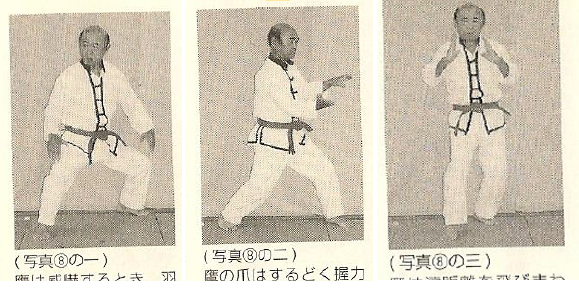Seienchin (Seiunchin) is one of the core Goju-Ryu kata and usually one of the early ones you'll learn. Typically this comes after Saifa, although the Meibukan seems to have it later in their curriculum. With most of the Goju-Ryu kata, there's not a whole lot of historical information that's been published and most of it boils down to "Kanryo brought in back from China".
I thought today I'd share a translation I did on Seienchin from Akio Kinjo's book, Karate Denshin Roku. Kinjo trained with Seiko Higa and Chosin Ishimine before later going to China to study various kung fu styles and the origins of karate. I still think his book is probably one of the most detailed but sadly it's never received an English translation.
セイインチン (青鷹戦) Seienchin (Blue Hawk Battle)
This kata is a kata of Goju Ryu that Kanryo Higaonna has transmitted, but after the transmission, it has been Okinawanized. The pronunciation has changed slightly depending on the kai-ha (school), such as `seiinchin'`sēenchin' `seiyunchin' and so on. 「セイインチン」「セーエンチン」 「セイユンチン」
In this kata as well as other kata before the war, they were expressed in katakana characters, but after the end of the war, various types of kanji are used.
Depending on the kai-ha the kanji: 「清栄戦」「征遠鎮」「制引戦」「制引鎮」can be used.
Correctly it is "青鷹戦" and " Chieiinchin" 「チエイインチン」 in Fukkien-Go.
It is a kata created by incorporating the conflict and movements of the "hawk".
An analysis of the contents of the Goju Seienchin kata shows the first photograph is a posture in which the wings are spread and inflated to intimidate the opponent when confronted with a strong enemy. The second figure is a posture in which the opponent’s forearm is gripped by a claw. The third picture is the last technique of Goju Ryu Seienchin, This is exactly the appearance of a hawk after its activity, landing on a tree branch and resting with a cool breeze by opening the wings to lower the body temperature, which means the end of the kata.
 |
| Seienchin postures from Kinjo's book |
So, for the most part, Akio Kinjo believes this was a hawk related kata. As a side note, this kata also seems to have the most variety in how it's written/spelled. In my lineage of Goju (Higa Izumikawa) we say Seienchin, others sometimes say Seiunchin or Seiyunchin.




